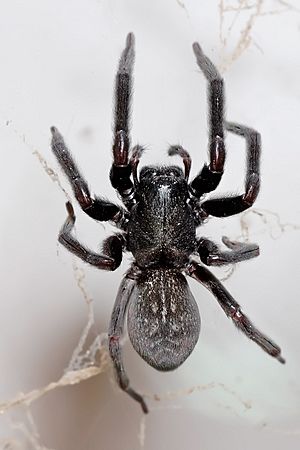Black house spider facts for kids
Quick facts for kids Black house spider |
|
|---|---|
 |
|
| Female black house spider | |
 |
|
| Male black house spider | |
| Scientific classification | |
| Synonyms | |
|
The black house spider (Badumna insignis) is a common Australian spider. You might also hear it called the common black spider. These spiders have also been found in New Zealand and Japan. There's a similar spider, the grey house spider (Badumna longinqua), which lives in similar places and has also spread to the Americas.
A scientist named Ludwig Carl Christian Koch first described the black house spider in 1872.
Contents
What Does a Black House Spider Look Like?
Black house spiders are dark and strong-looking spiders. Female spiders can grow up to 18 mm long. Their legs can spread out to about 30 mm. Male spiders are smaller, usually around 10 mm. They also have longer legs compared to their body size.
Both male and female spiders have dark brown to black bodies and legs. Their abdomen (the back part of their body) is dark grey. It often has light markings and is covered in fine, soft hairs. The grey house spider is a bit bigger (14 mm). It has a grey body and black-brown legs.
Where Do Black House Spiders Live and What Do They Do?
Black house spiders build webs that look a bit messy. They are made of irregular, sail-like shapes. In the middle or corner of the web, there's a funnel-shaped silk tunnel. This is where the spider usually waits for its prey.
Female spiders almost never leave their webs. They seem to really like their spot! Because of this, old webs can get quite dusty. They might even have small objects stuck in them. At night, the spider comes out to fix and add to its web. It often just adds new silk over the old parts.
When male spiders are ready to mate, they go looking for females. The male will gently pluck the female's web to get her attention. If the female is interested, the male will approach her. They might stay together for several days and mate more than once.
Spider Babies
The female spider lays her eggs in several white silk sacs. She hides these sacs inside her web tunnel. She stays with the eggs until they hatch. After hatching, the baby spiders (called spiderlings) spread out. Sometimes, the young spiders stay with their mother for a while. They help catch smaller insects that the bigger spider might not bother with.
Other animals that hunt black house spiders include the white-tailed spider. Some types of parasitic wasps and flies also prey on them.
Are Black House Spider Bites Dangerous?
Black house spiders have venom, but they are not considered very dangerous to humans. They are usually shy and don't often bite people. If a bite does happen, it can be painful and cause swelling where it occurred. Sometimes, people might feel sick, vomit, sweat, or feel dizzy. In rare cases, if someone is bitten many times, a small skin sore might develop.
Where Can You Find Black House Spiders?
Black house spiders are originally from Australia. They have also been found in New Zealand and Japan. You can find them all over Australia and New Zealand.
In nature, they often live on trees with rough bark. Inside buildings, they like corners, windows, and doorways. These spots are good because light sources often attract insects, which are their food. The similar grey house spider can be found in similar places. However, it is more often found outdoors.

